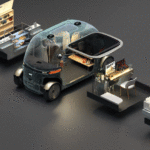Danit Peleg is a fashion designer with a keen eye for the future. While implementing 3D printing into fashion is nothing new, her online concept is immensely clever. On danitpeleg.com, users can design their own jacket and have it 3D printed, fitted and delivered in just a few clicks.
Peleg has previously touted the benefits of 3D printing fashion and accessories in a TED talk. This website is a culmination of those same principles outlined in the talk. Customisation, precision and personalisation all play a pivotal role in this online application.
The website has a simple yet elegant interface with host of features. Aside from allowing users to pick sizes it also has a virtual fitting feature. With the aid of Nettelo, the website can help achieve the exact fitting customers need. Netello allows users to send their measurements, at which point, the designers will send them an email with information about the fitting session.
Users can pick out colors, textures, lining and even inscribe a word into the design. Danit Peleg picked this specific garment so that it could fit in with casual clothing like jeans. The jacket is a limited edition product of 100 units and can be quite expensive. It can set back buyers by about $1,500. Each jacket takes 100 hours to print, which may seem long but is actually faster than the time it took to print her first collection. They also take about 3 months to deliver (dependant on how many orders are in the pipeline).
Peleg came up with this idea whilst trying to fit a dancer for the Paralympics. As a result, she turned to Netello for a virtual fitting session. Now she has partnered with partnered with Recreus, a Spanish company that makes Filaflex, a flexible filament for 3D printers. Consequently, all the prints have to come from Spain.
3D Printed Fashion
3D printing has been on the periphery of the fashion world. Projects in fashion are not uncommon but there are skeptics as to its usefulness. Projects like this one and Dita von Tees’ 3D printed gown are a good example of how precise and diverse 3D printed clothing can be. Even though, at this point, these clothes take longer and are dependant on traditional methods, the possibilities are immense.
Like Danit Peleg’s website, designers have tools that can shake up the production and retail system. The technology can allow for printing things within your own home or ordering online.
We can see the growth of 3D printing in fashion if we look around. Considered the pioneer of 3D printed fashion, Iris van Herpen has made dresses for celebrities such as Bjork. Similarly, Adidas has been making the Futurecraft 4D, which has a 3D printed shoe sole, for quite some time now. I’d say, it’s only a matter of time before you can find a head to toe 3D printed clothes ensemble in your local store.










